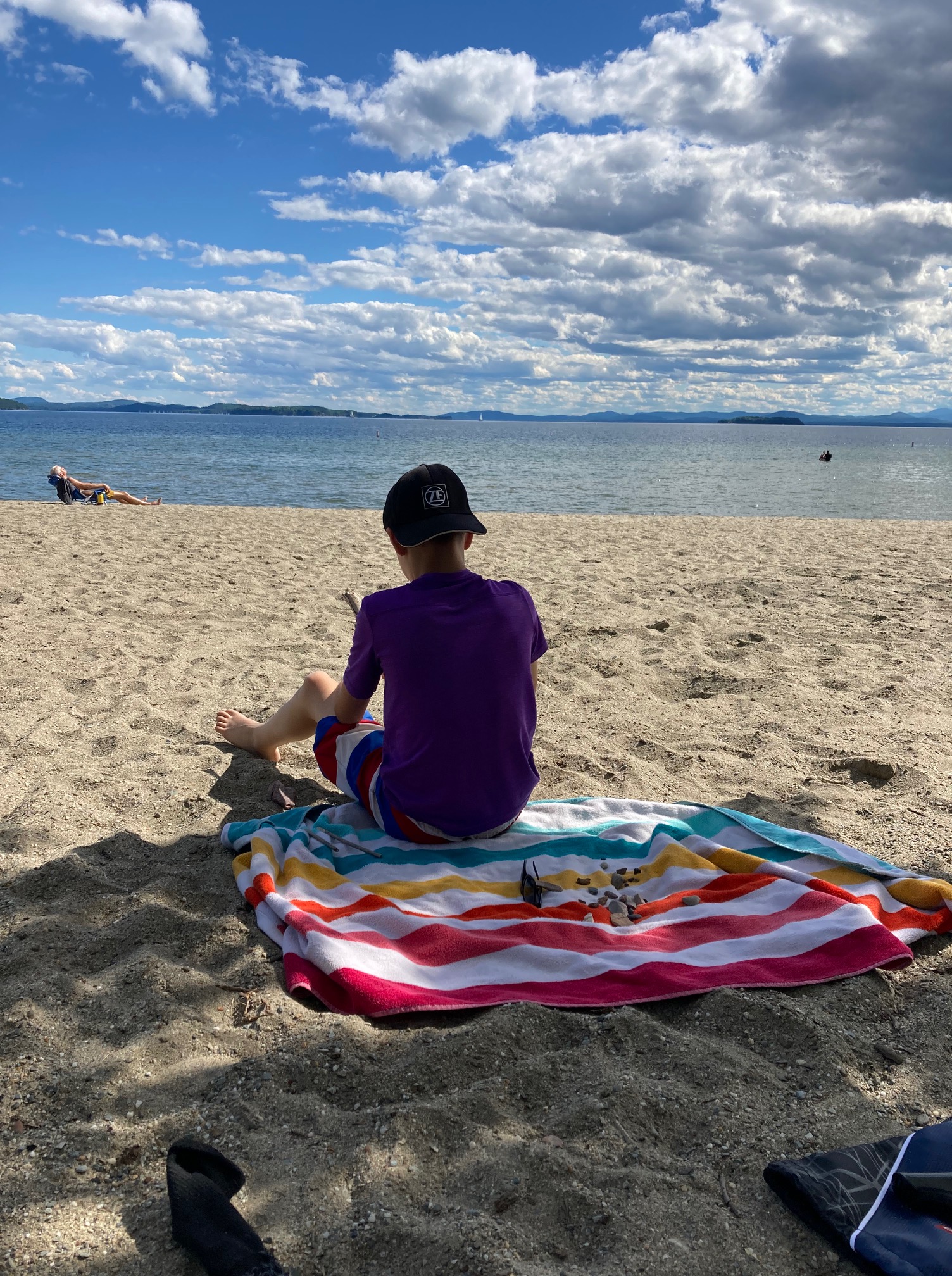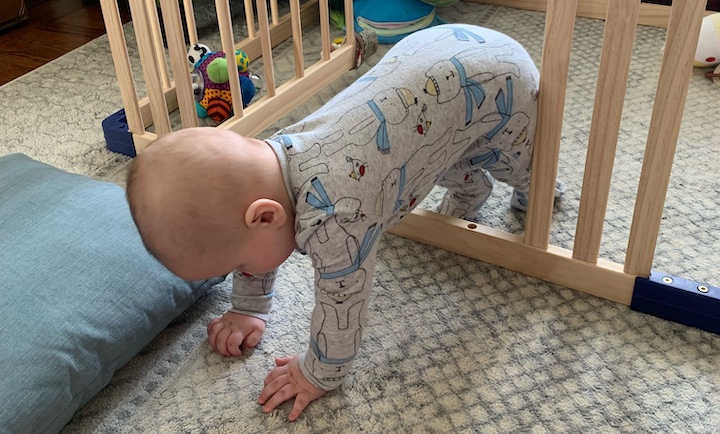Alice and her wife Ann live in a small northern New England town with their two sons and two dogs. Both Alice and Ann are educators and enjoy their work. Their children were adopted from the foster care system and both have significant early childhood trauma. Due to this, they have intensive needs and Alice and Ann have organized their family life around addressing these needs.
Practically, this means Alice is the primary at-home parent managing a constellation of doctors, social workers, school interventions, therapists, medication management, and mental health crises. As a result, she’s only able to work part-time. Although the state pays for their sons’ health insurance and an adoption subsidy, this doesn’t match the financial reality of caring for their children. Ann and Alice are living below their means right now, but are concerned they don’t have enough money saved to continue this level of care once their kids are legal adults. Thus, Alice has asked for our help in assessing her financial situation and ensuring she’s on a sustainable path for the future.
What’s a Reader Case Study?
Case Studies address financial and life dilemmas that readers of Frugalwoods send in requesting advice. Then, we (that’d be me and YOU, dear reader) read through their situation and provide advice, encouragement, insight and feedback in the comments section.
For an example, check out the last case study. Case Studies are updated by participants (at the end of the post) several months after the Case is featured. Visit this page for links to all updated Case Studies.
Can I Be A Reader Case Study?
There are three options for folks interested in receiving a holistic Frugalwoods financial consultation:
- Apply to be an on-the-blog Case Study subject here.
- Hire me for a private financial consultation here.
- Schedule an hourlong call with me here.
To learn more about private one-on-one consultations, check this out.
Please note that space is limited for all of the above and most especially for on-the-blog Case Studies. I do my best to accommodate everyone who applies, but there are a limited number of slots available each month. Another way to get Frugalwoodsy advice is to…
Join a UFM Mastermind Group
There’s a BRAND NEW way to participate in my Uber Frugal Month Challenge: join a Mastermind Group!!!! These groups are your chance to meet (on video) with me and 9 other frugal folks once a week for 5 weeks starting in January! Read more here; sign-up to join here.
The Goal Of Reader Case Studies
Reader Case Studies highlight a diverse range of financial situations, ages, ethnicities, locations, goals, careers, incomes, family compositions and more!
The Case Study series began in 2016 and, to date, there’ve been 88 Case Studies. I’ve featured folks with annual incomes ranging from $17k to $200k+ and net worths ranging from -$300k to $2.9M+.
I’ve featured single, married, partnered, divorced, child-filled and child-free households. I’ve featured gay, straight, queer, bisexual and polyamorous people. I’ve featured women, non-binary folks and men. I’ve featured transgender and cisgender people. I’ve had cat people and dog people. I’ve featured folks from the US, Australia, Canada, England, South Africa, Spain, Finland, Germany and France. I’ve featured people with PhDs and people with high school diplomas. I’ve featured people in their early 20’s and people in their late 60’s. I’ve featured folks who live on farms and folks who live in New York City.
Reader Case Study Guidelines
I probably don’t need to say the following because you folks are the kindest, most polite commenters on the internet, but please note that Frugalwoods is a judgement-free zone where we endeavor to help one another, not condemn.
There’s no room for rudeness here. The goal is to create a supportive environment where we all acknowledge we’re human, we’re flawed, but we choose to be here together, workshopping our money and our lives with positive, proactive suggestions and ideas.
A disclaimer that I am not a trained financial professional and I encourage people not to make serious financial decisions based solely on what one person on the internet advises.
I encourage everyone to do their own research to determine the best course of action for their finances. I am not a financial advisor and I am not your financial advisor.
With that I’ll let Alice, today’s Case Study subject, take it from here!
Alice’s Story

Hello friends, I’m Alice and I’m 47. My wife Ann (age 51) and I live in a small northern New England town located in a valley near lakes, rivers, mountains and miles of skiing/hiking trails. We love it here and spend as much time outside as possible, enjoying our place in the world. Our boys, ages 14 and 12, also love being outside: playing with the dogs, biking, and swimming. I’m an enthusiastic–albeit subpar–homesteader who is constantly expanding the garden and planting new trees.
Ann loves biking, watching movies, and cross-country skiing on the weekends. We also spend a lot of time standing on soccer field sidelines, cheering for our kids. Ann is an IT teacher in a large public school and I’m a part-time teacher and tutor. Our older son has a regular babysitting job and our younger son pet-sits and does light landscaping for neighbors. Our dogs, however, do not have jobs… hmmm.
I am so grateful to Mrs. FW and this blog. I’ve been a reader for several years and have taken much of the advice on these pages to heart. We’ve prioritized:
- Paying off our debts (mortgage, car payments and student loans)
- Building an emergency fund
- Investing in our retirement accounts
- Using cash-back credit cards
- Having a high-interest savings account
- Switching to financial companies with low or no fees
We’ve used “extra” money (gifts, tax returns, side income) to make our home as energy efficient as possible and purchase an electric car. We’ve also been incredibly fortunate that we have the resources and support to parent our beloved kids.
What feels most pressing right now? What brings you to submit a Case Study?
I wanted to submit a Case Study because our family has a unique set of circumstances that affect our finances and I thought Mrs. FW could help! Our children were adopted from the foster care system and both have significant early childhood trauma. Because of this rough start, they have intensive needs and consequently, we have organized our family life around helping and addressing their needs. Practically, this means I am the primary at-home parent managing a constellation of doctors, social workers, school interventions, therapists, medication management, and mental health crises. Due to this, I’m only able to work part-time. The state pays for their health insurance and pays us an adoption subsidy, both of which will end when they turn 18. While we are grateful for this support, it doesn’t match the financial reality of caring for our children. Having high-needs kids means there are a thousand little costs–mileage, lost wages, last minute take-out, respite care, convenience services (lawn mowing, etc..)–that all add up. We’re living below our means right now, but I’m concerned we don’t have enough money saved to continue this level of care once our kids are legal adults. This NPR article articulates many of our concerns (and experiences): Paying for mental health care leaves families in debt and isolated.
What’s the best part of your current lifestyle/routine?

Ann and I love each other and are deeply committed to our partnership and family. We make each other laugh and support each other as individuals and as parents. Our sons are smart, energetic, creative, and loving and it is my great joy to be their mom.
My family is the best part of my life.
It’s also true that our home life is very stressful because of the boys’ behaviors and needs. This stress is balanced by our daily outside time, frequent dates with my wife, and a strong, supportive community of foster/adoptive parents. We both love our work and find meaning in what we do for a living.
What’s the worst part of your current lifestyle/routine?
We have to do it all. We’ve built the web of support necessary for our family, but when one strand of the web breaks, things get shaky. I’m doing this Case Study so that I can strengthen the financial strand of that web.
Where Alice & Ann Want to be in Ten Years:
- Finances:
- Both of us working part-time to cover living expenses only (is this called Coast FI?)
- Enough in retirement savings to maintain a modest standard of living for the two of us, which I believe will be about $5,000/month. Our estimated Social Security is $2,600/month, so we’ll need to drawdown our retirement investments at $2,400/month.
- Have a substantial savings account for emergencies for our kids as well as 6 months of living expenses for us. $60,000 seems like a reasonable goal.
- Lifestyle:
- Move to a smaller house that requires less maintenance and has an attached apartment. The apartment may be used by one of our adult children and/or a tenant who will provide passive income.
- Even more outside time! I would love to do a long trip once the kids are more self-sufficient; something like distance hiking or paddling a river from its source to the sea.
- Continue to invest in, and prioritize, my relationship with Ann.
- Career:
- I don’t foresee either of us fully retiring in the next 10-15 years, but rather, working part-time or seasonally. We both love what we do.
Alice & Ann’s Finances
Income
| Item | Amount | Notes |
| Ann’s net income | $5,145 | Minus taxes and mandatory state retirement |
| Alice’s net income | $1,200 | Hourly employee, average over the last 6 months |
| Adoption subsidy | $1,395 | Non-taxable |
| Alice’s side income (tutoring, user testing) | $200 | Varies |
| Monthly subtotal: | $7,940 | |
| Annual total: | $95,280 |
Mortgage: paid off; home is valued at $350k
Debts: $0
Assets
| Item | Amount | Notes | Interest/type of securities held/Stock ticker | Name of bank/brokerage | Expense Ratio |
| Ann Family Trust | $681,820 | Ann’s family owned a business that she helped to run, this is from the sale of that business | This is an investment account held equally by Ann and her two siblings. The total listed is Ann’s portion.
She does have access to the money but the siblings decided not to divide it up until after Ann’s mom passes. It is accessible without major restrictions, but is in no way an emergency fund or something we could access tomorrow. |
Fidelity | Unsure |
| Alice Roth IRA | $98,054 | Try to contribute max per year | Vanguard Target Retirement Fund 2040 | Vanguard | 0.08% |
| Ann State Retirement A | $62,000 | State pension fund, hard to get an exact number; this is how much she has contributed | State | ||
| Alice 403b | $37,962 | From previous employer, cannot roll over | CREF Social Choice R1 (QCSCRX) | TIAA | 0.42% |
| Ann State Retirement B | $27,120 | State pension fund, hard to get an exact number; this is how much she has contributed | State | ||
| HSA | $13,300 | Equal to medical insurance deductible for one year | Lively | 0% | |
| High interest Savings | $15,000 | Usually have $20,000 in this account; we just had an emergency and a major house repair, which is why this is lower than average | Discover | 2.75% | |
| Checking | $9,850 | No fee checking | Local bank | 0.5% | |
| Roth IRA for older son | $1,987 |
Target date fund |
Vanguard | 0.08% | |
| Roth IRA for younger son | $1,987 | Target date fund | Vanguard | 0.08% | |
| TOTAL: | $936,997 |
Vehicles
| Vehicle make, model, year | Valued at | Mileage | Paid off? |
| Toyota RAV4 Hybrid 2020 | $30,000 | 35,000 | Yes |
| Hyundai Kona EV 2019 | $28,000 | 15,000 | Yes |
Expenses
Our below budget is based on our last 6 months of expenses (thank you, Personal Capital, for making it so easy to pull these numbers!). During that time, one child had daily intensive outpatient therapy, one needed to be homeschooled for a time, and two family members were in the ER. I don’t know how to express this reality in a budget, but I do know that it affects our financial stability and future.
| Item | Amount | Notes |
| Groceries | $1,102 | Umm, yes, my kids eat a lot. |
| Kid tuition | $922 | Independent school, necessary expense |
| Health insurance and health expenses | $520 | High deductible health plan (ACA exchange), pay most health care costs out of pocket, expect this will go up significantly in 2023 |
| Property taxes | $413 | |
| Maintenance and repairs | $410 | Our house is very old and something is always breaking. Always. Breaking. |
| Restaurants | $368 | |
| Dogs | $364 | Two big happy dogs, includes boarding during vacation |
| Electric | $320 | We have mini-splits (heating/cooling) and have an electric car. |
| Therapy | $300 | |
| Clothes/shoes | $230 | Wowzah! |
| Vacation | $220 | Camping and 1 AirBnB vacation |
| Gas | $181 | |
| Kid tutoring | $160 | Private tutoring to address learning disability |
| Sports/day camps | $150 | |
| Insurance | $146 | This just went up so much! (I did shop around.) |
| Insurance | $132 | |
| Cell phones (4) | $116 | Have an MVNO, great service and great coverage. |
| Gifts | $108 | |
| Clothes/shoes | $104 | |
| Plowing/mowing | $100 | |
| Hobbies/entertainment | $100 | Disney+, coffee with friends, date nights, concerts |
| Giving | $100 | |
| Propane | $98 | Pre-pay every year |
| Maintenance/tires | $80 | |
| School lunch for Ann | $60 | |
| Town sewer | $55 | |
| Quarterly exterminator service | $42 | Old house = lots of unwanted critters |
| Trash pick up | $42 | No municipal services where we live. |
| 2 cords of wood | $40 | Love our wood stove! |
| Internet | $40 | |
| Allowance | $40 | |
| Life insurance | $39 | |
| Hot water heater/wood stove yearly maintenance | $30 | |
| Hair cuts | $20 | |
| Hair cuts | $15 | |
| Tax prep | $10 | Thank you TurboTax |
| Monthly Subtotal: | $7,177 | |
| Annual Total: | $86,124 |
Credit Card Strategy
| Card Name | Rewards Type? | Bank/card company |
| Chase Freedom Unlimited® | 1.5% cash back | Chase Bank (affiliate link) |
| Discover | 1% cash back |
Alice’s Questions For You:
1) Are there any readers who have experience with transitioning high-needs kids from adolescence to adulthood?
- I need all of the advice you can throw (type) at me, specifically about medical insurance and SSI.
2) We save about $800/month and use it to fund Alice’s Roth IRA, the HSA, and our savings account, which is our emergency fund.
- Is there a better distribution for this financial cushion?
- Should we be saving our emergency fund in two categories: 1) kid related; 2) general emergencies?
- What is a series I-bond? I googled it and don’t get it. Is this a place to hold some emergency money long-term?
Liz Frugalwoods’ Recommendations

I want to thank Ann and Alice for sharing their story with us. They bring us a difficult, but important, situation with their two high-need kids and I’m thankful for their transparency in sharing their struggles and questions. We all have diverse, unique, personal money stories; furthermore, the way that money intersects with our lives isn’t always neat and tidy.
I’m grateful to every Case Study subject for their willingness to share because these Cases aren’t just for the subjects–they’re also for everyone reading. They’re an opportunity for us to delve into different financial topics and learn from one another. And so, thank you Ann and Alice for allowing us to broach this difficult topic today.
Alice’s Question #1: Are there any readers who have experience with transitioning high-needs kids from adolescence to adulthood?
My chief advice for Alice and Ann is that they should hire a lawyer if they haven’t already.
Everyone needs a will and estate plan, created by a lawyer (don’t DIY something this important), but it becomes even more imperative when you have kids with special needs or high levels of need. There are a number of different legal constructions available in these situations with the most common–in my limited knowledge–being a Special Needs Trust (SNT).
According to the Special Needs Alliance:
A special needs trust (SNT) is a trust that will preserve the beneficiary’s eligibility for needs-based government benefits such as Medicaid and Supplemental Security Income (SSI). Because the beneficiary does not own the assets in the trust, he or she can remain eligible for benefit programs that have an asset limit. As a general rule the trustee will supplement the beneficiary’s government benefits but not replace them. Examples of supplemental needs are costs for sitters, companions, and dental or medical expenses not covered by Medicare or Medicaid.
The need for an SNT (or other legal construction) is obviously dependent upon the level of care Ann and Alice predict their children might need after the age of 18. It’s impossible to predict the future, but this is something they should consult with an attorney about.
The inherent challenge in answering this question is that a lot of their future expenses (and financial health) will depend on whether or not their kids are still living with them after age 18. As it stands now, many of their expenses are kid-related and it’s hard to know what their expenses will be without putting a likelihood on the kids still living with them/supporting them. Their financial picture will look dramatically different if the kids are living with them/being fully financially supported by them versus not and only occasionally needing financial help for emergencies.
They should also be sure to ask their lawyer whether or not it makes sense to have money in Roth IRAs for each kid as these would be counted as assets in the children’s names and thus could disqualify them from future government benefits.
One salient question for Alice and Ann: do you envision college, or another secondary trade school, as an option for either/both of the kids?
To the healthcare aspect of Alice’s question, that is one area where an SNT can help as it would preserve the kids’ eligibility for Medicaid and SSI. Additionally on the healthcare topic, I am curious about the monthly $520 healthcare line item. Since it’s open enrollment season now, I strongly suggest Alice and Ann shop this around a bit as a $520 per month premium for just the two adults seems very high to me.
My questions:
- Does Ann’s workplace offer health insurance? As she’s employed at a public school, her employer-sponsored health plan should be excellent. I urge Alice and Ann to revisit what it would cost them to instead both be on Ann’s workplace insurance.
- If they want to remain on the ACA, I encourage them to research the subsidies offered by their state as it appears to me they are overpaying. ACA subsidies are determined by your income (not your assets) and there is no cliff for subsidies–it’s a sliding scale.
I think this’ll be well worth their time to investigate.
Alice’s Question #2: We save about $800/month and use it to fund Alice’s Roth IRA, the HSA, and our savings account, which is our emergency fund.
This calls for a full financial overview, my friends! Let’s take a look at each of their accounts in turn.
Retirement: $225,136
1) Pensions: Need to Learn the Details

The big wildcard here are Ann’s pensions. This is another area I encourage them to research fully. As a state employee (in a public school), Ann’s pension is likely excellent. Knowing these details will help paint a much more lucid picture of their retirement investments. They should reach out to Ann’s HR/Benefits coordinator and learn everything they can. Some districts/states offer periodic seminars on “understanding your pension,” which would be a great place to start.
2) Social Security: Calculate Anticipated Benefits
Edited 11/11/22: Thanks to commenter Sarah, I see that Alice DID in fact provide their estimated SS, which is great! Thus, they can disregard the below advice, but I will leave it here in case it’s helpful to anyone else. Thank you, Sarah!!
The above retirement total also doesn’t include what they’ll each receive in Social Security. To figure out their anticipated Social Security benefits, Ann and Alice should follow these instructions on how to retrieve their earnings tables from ssa.gov (the government’s Social Security website).
Aside from the full pension benefits and Social Security, Ann and Alice have $225,136 in retirement investments. Let’s see how that stacks up against Fidelity’s retirement rule of thumb:
Aim to save at least 1x your salary by 30, 3x by 40, 6x by 50, 8x by 60, and 10x by 67.
As they’re both circa age 50, we’ll go with 6 x $95,280, which is $571,680.
From this perspective, they’re behind. However, again, without knowing the full pension details and their anticipated Social Security, it’s impossible to accurately assess their progress. Once they gather that information, they’ll be able to plug in the numbers and have a much clearer picture of where they stand.
If they determine they need to beef up their retirement investments, they could have Ann open either an IRA or Roth IRA. This would be in addition to Alice’s existing IRA.
A Roth IRA is:
- A retirement account that’s post-tax
- That means you pay taxes on the money you put into a Roth IRA, but you don’t pay taxes when you withdraw the money in retirement.
- A Roth IRA grows tax free.
- You need to be age 59.5 before you can withdraw money penalty-free (although there are exceptions).
- Your eligibility to contribute to a Roth IRA depends on your income and your particular tax situation.
- The maximum annual contribution amount in 2023 will be $6,500.
- The IRA catch-up contribution limit for individuals aged 50 and over is $1,000.
- I like this article on Roth IRAs if you want to read more.
A Traditional IRA is:
- A retirement account that’s pre-tax
- This means you don’t pay taxes on money you put into an IRA, but you do pay taxes when you withdraw the money in retirement.
- There are no income limits. Anyone can contribute to a traditional IRA.
- You need to be age 59.5 before you can withdraw money penalty-free (although there are exceptions).
- More about traditional IRAs here.
- The maximum annual contribution amount in 2023 will be $6,500.
- The IRA catch-up contribution limit for individuals aged 50 and over is $1,000.
A person can have both a Roth and a traditional IRA, but their combined annual contribution to both can’t exceed the limit.
Since Ann is 51, she could contribute a maximum of $7,500 per year to an IRA (Roth or regular) and Alice (at 47) can max out at $6,500.
Cash: $24,850

Your cash-on-hand, also known as your emergency fund, should cover 3 to 6 months’ worth of your spending.
- At Alice & Ann’s monthly spend rate of $7,177, their emergency fund would cover just over three months, which makes it right on target. Very well done!
I also commend them for having some of this money in a high-interest savings account as that is FREE MONEY, people! A high-interest savings account is pretty much the only good thing about inflation and the Feds continually raising interest rates. Make sure you are taking advantage of this as it’s the easiest way to leverage your $$$.
My question for Alice and Ann is why they have so much of this money ($9,850) in a checking account that earns only 0.5% interest? I understand the need to have a local bank account and I have one myself; however, I keep the bare minimum in that account since they offer me NOTHING in return.
Roth IRAs for Both Kids: $3,974
As noted above, I recommend Alice and Ann speak with a lawyer about how to structure savings/investments for their kids.
Health Savings Account (HSA): $13,300
Makes sense to me to utilize an HSA if you have one. I still encourage Alice and Ann to do some research around their healthcare plan, as discussed above.
Ann’s Family Trust: $681,820
I saved the big kahuna for last because we don’t have enough visibility into this account to properly assess it. I can appreciate the complicated family dynamics that might be at play here, but, it does represent over 72% of their overall net worth and so it is a tad concerning that Alice and Ann don’t know what this is invested in. I am cheered to see that it’s held at Fidelity as that’s a brokerage with a reputation for well-respected total market low-fee index funds. However, since we don’t know which funds at Fidelity this is in, we can’t say for sure if it’s being invested properly.
Investing 101

Alice and Ann have a very high financial IQ and to their credit, have done an excellent job mastering and implementing the most important basic elements of responsible money management. I think the area they can consider a growth opportunity for themselves is investing prowess. The funds you invest in are a critical aspect of your longterm financial health and the good news is that it’s not too complicated to educate yourself. I highly recommend the book The Simple Path to Wealth by JL Collins as a primer on investing (affiliate link). It’s well-written, funny, easy-to-understand and has great advice.
For Alice and Ann (and anyone else out there reading), the basics of Collins’ book–and my own personal investing strategy–are:
1) Choose a brokerage with low fees.
A brokerage is a company that sells you the stocks you invest in. For reference, the following three brokerages offer DIY low-fee investment options:
- Fidelity’s Total Market Index Fund (FSKAX) has an expense ratio of 0.015%
- Charles Schwab’s Total Market Index Fund (SWTSX) has an expense ratio of 0.03%
- Vanguard’s Total Market Index Fund (VTSAX) has an expense ratio of 0.04%
Wondering how to find a fund’s expense ratio? Check out the tutorial in this Case Study.
2) Select low-fee (as noted above), total market index funds.
The rationale behind this is that, in general, investing in a total market index fund gives you the broadest possible exposure to the stock market. In a total market index fund, you’re essentially invested in a teensy bit of every single company in the stock market, which gives you a ton of diversity. If one company–or even one sector–tanks, your entire portfolio isn’t toast. It’s the “not putting all of your eggs in one basket” version of investing. It’s what I do, it’s what the vast majority of FIRE folks do and, best of all, it’s easy to implement and maintain.
3) Don’t panic sell. Or panic buy.
The smartest way to invest is on a regular basis and for the longterm. Ideally, you want to invest money in the market and then not touch it for decades. During this time, the stock market WILL go up and down (that’s literally what it’s designed to do). However, you–the savvy investor–won’t pay it any mind. The only thing that following the market will give you is indigestion.

The key is to remember the data on historical stock market returns. And now, enjoy some data:
The average annualized return since its [S&P 500’s] inception in 1928 through Dec. 31, 2021, is 11.82%.The average annualized return since adopting 500 stocks into the index in 1957 through Dec. 31, 2021, is 11.88% (source: Investopedia).
Sounds great, right? We’re all going to make 11.82% every year on our investments? WRONG. You will, if you are lucky, make that percentage OVER TIME and on average. One year, you may lose a lot. The next year, you might gain a lot. It’s a looooooooooooonnnnng game that does not favor the tentative.
I, personally, utilize 7% as my estimate for what I can expect the market to deliver as an annual average. In all things, I like to underestimate and then be pleasantly surprised if it’s better than I predicted. Also, as this article notes:
Inflation is one of the major problems for an investor hoping to recreate that 11.88% average return regularly. Adjusted for inflation, the historical average annual return is only around 8.5%.
That makes my 7% seem a lot more reasonable. Furthermore, people argue about what the actual accurate, inflation-adjusted return rate is:
When looking at nearly 100 years of data — from 1926 to 2021 — the yearly average stock market return was between 8% and 12% only eight times. In reality, stock market returns are typically much higher or much lower (source: SoFi).
To put a finer point on it, the NYU Stern School of Business made this very nice chart outlining the annual returns from the S&P 500 since 1995 and, as you will see, some years it’s good and other years, it’s pretty bad. In 2008, for example, it was -36.55%. YIKES. However, the savvy investors who kept their nerve and didn’t sell that year went on to enjoy a 25.94% return in 2009, followed by more good years including a whopping 32.15% return in 2013.
Remember: People only “lose it all” in the stock market when they sell their stocks at a loss and don’t remain invested for the long term.
4) Is it Ever Wise to Invest in Individual Stocks?
In my opinion, no. If that one company whose stock you hold goes down, your investment plummets. If Apple or Amazon or Netflix or whoever has a bad quarter, you have a bad quarter. If you are instead invested across the entire stock market, companies can go bankrupt and your portfolio will still bob along with the broader stock market. Investing in an individual stock is the epitome of “putting all your eggs in one basket.” I consider investing in individual stocks to be a hobby, not a financial strategy. If you really enjoy day trading and want to do it for fun, go right ahead! But I wouldn’t do it with money I need. In my opinion, it’s not much safer than going to a casino.
5) When Should You Use Your Taxable Investments?

Ideally, you will keep your money invested for the decades, until you retire. When you retire, you can begin to drawdown a percentage of these funds each year to cover your living expenses. As you near retirement, you’ll want to reduce the risk exposure of these investments so that you’re buffered from any major market downturns in the run-up to your retirement.
How This Applies to Alice and Ann
Alice and Ann have the majority of their net worth (not considering their paid-off home) invested in the stock market. In light of that, they’ll want to ensure they’re following the above investing basics. Chief among them: selecting a brokerage with low-fee, total market index funds and investing in those funds.
Specifically:
- I encourage them to investigate what Ann’s trust is invested in at Fidelity as a high expense ratio will leech money from that total over the years.
- Alice’s Roth IRA has a fairly low expense ratio (0.08%), but there are lower fee options available.
- Alice’s old 403b at TIAA is the major area for concern. At 0.42%, she’s losing a lot of money to fees.
- She notes that it “cannot be rolled over,” but that shouldn’t ever be the case. Here’s TIAA’s website on how to execute a rollover.
- There should be a way for her to roll this over into an IRA at a brokerage with low-fee offerings.
- And, retirement accounts aren’t impacted by capital gains taxes, so that shouldn’t be an issue.
- I can almost guarantee that TIAA will give her a very hard time about it, but it’ll be a worthy battle.
And now, onto the other parts of Alice’s question:
Is there a better distribution for this financial cushion?

I don’t think so. Their emergency fund is fully funded and their retirement is a wild card until they determine the pension and SS benefits. As noted above, if they are behind on retirement after determining these two variables, they can have Ann open up an IRA and max it out. As for the kids, I recommend they speak with a lawyer about how to structure those savings/investments.
Should we be saving our emergency fund in two categories: 1) kid related; 2) general emergencies?
This is really a question of personal preference. There’s no financial advantage to having two different emergency funds, so it’s more of an administrative preference. If it would be helpful to Ann and Alice, they can certainly divide up their emergency fund. For me personally, I find it more streamlined and easier to just have everything all in one place, but it’s totally up to them.
What is a series I-bond? I googled it and don’t get it.
A Series I Savings Bond is a bond sold by the US government that earns both, “…a fixed rate of interest and a rate that changes with inflation. Twice a year, we set the inflation rate for the next 6 months” (source: The US Department of the Treasury). The idea is that it’s supposed to keep up with inflation, which makes it very attractive in our current inflationary market.
Is this [a series I bond] a place to hold some emergency money long-term?
Yes and no. It depends on your life, your risk tolerance, how variable your expenses are, and how much “extra” money you have on hand. The reason being is that putting your money in an I Bond locks it up. It’s no longer liquid. You can’t withdraw it tomorrow when your car breaks down. Here’s how the Treasury Department explains it:
“You can cash in (redeem) your I bond after 12 months. However, if you cash in the bond in less than 5 years, you lose the last 3 months of interest. For example, if you cash in the bond after 18 months, you get the first 15 months of interest.”

What they’re saying is that you cannot get your money out before one year passes. And if you take your money out sooner than 5 years, you lose the last three months worth of interest. Therefore, you do not want to put money in here that you might need. I do not recommend that anyone utilize an I bond as an emergency fund because it’s not one. By its very definition, an emergency fund MUST be held in easily accessible cash. An I bond isn’t going to do you any good if your dog gets quilled by a porcupine and has to go to the emergency vet. Your emergency fund should be money that you can access when you’re standing in the ER, at the vet, at the mechanic’s, etc.
In Alice and Ann’s case, my advice would be to not put their money into an I Bond at this time because:
- They only have three months’ worth of their expenses in cash. This is the bare minimum to have on hand. If they had, say, a year’s worth of cash, then an I Bond might make sense for half of that cash.
- Additionally, given the variability they experience with their kids’ needs, I wouldn’t recommend they tie up their emergency fund.
Summary:
- Hire a lawyer to advise them on how to structure savings/investments for their sons’ future. Explore whether a Special Needs Trust or other vehicle will be most appropriate.
- Be sure to ask the lawyer about whether or not to continue investing in Roth IRAs for each child.
- Research healthcare options:
- As a public sector employee, Ann’s employer-sponsored healthcare plan might be cheaper for the two of them.
- If not, explore the other options through the ACA and make sure they’re applying all of the subsidies they qualify for based on their income.
- If they do change insurance, re-assess if the level of HSA contribution continues to make sense.
- Delve into Ann’s pension plan details and ensure they fully understand the ramifications. Ask HR for help–they are there for this purpose.
- With the knowledge of Ann’s pension and SS benefits in hand, assess their progress towards retirement.
- If they need to catch up, consider opening an IRA for Ann and have her contribute the annual max ($7,500 in 2023).
- Keep their emergency fund in cash so that it’s there for them when they need it.
- Consider putting all of their cash (or the majority of it) into their high-interest account.
- Try to determine what Ann’s trust is invested in.
- Follow the investing guidelines above for the trust and all retirement accounts.
- Feel confident that they’re doing great and are on a solid financial path!
Ok Frugalwoods nation, what advice do you have for Alice? We’ll both reply to comments, so please feel free to ask questions!
Would you like your own Case Study to appear here on Frugalwoods? Apply to be an on-the-blog Case Study subject here. Hire me for a private financial consultation here. Schedule an hourlong call with me here, refer a friend to me here, or email me with questions (liz@frugalwoods.com).
Oh, and before I forget… Join a UFM Mastermind Group!
Money is something we’re not supposed to talk about and so many of us don’t. We harbor secret concerns, joys, frustrations, questions and don’t have an outlet for them. This is that outlet! These groups are the place to discuss every single weird money question you have. These groups are the place to share every single money success you experience. These groups are where you’ll find camaraderie and support.
There’s no question too big or too small for the groups to address because, for most of us, our financial educations began after we became adults, after we made some serious financial missteps (anyone remember my story about overdrawing my checking account in my 20s?). We feel like we SHOULD know this stuff and SHOULD be able to manage our money and so we don’t ask for help. Let yourself off the hook and come join us.
These Groups Exist to Address:
❤️ The lack of community and support you feel on your financial journey.
😱 Emotional turmoil around money–or financial trauma–that has sabotaged your past efforts to improve your financial health.
🤑 Complicated family dynamics and history that make it intimidating to figure out how to change your approach to money.
👀 An inability to stick with the habits promoted by the Uber Frugal Month for the long-term.
📚 A fear that you’re the only person who doesn’t understand financial terminology & jargon.
🧠 Lack of clarity on your long-term goals and how your money might impact your future.
🤷♀️ A disconnect between you and your partner/spouse about how money should be managed.
👎 Undesirable financial routines/expectations you’ve set up with your kids and want to change.
😬 Shame and guilt over not taking charge of your financial life sooner.
🤦♀️ Embarrassment over your lack of personal finance knowledge.
👏 How to create a sustainable money plan that you actually can–and will–follow.








I think Alice already provided Social Security estimates? “Our estimated Social Security is $2,600/month, so we’ll need to drawdown our retirement investments at $2,400/month.”
Oh geez, you are so right… what would I do without you guys?! Thank you, Sarah!
I’m not sure what New England state you’re in, but in NY state employees can calculate their estimated monthly pension online, or schedule a personal appointment with a representative. Definitely worth it, and huge for peace of mind. NYS also has the Office of Mental Health, which provides services and can help with some care costs — perhaps there is a similar state agency where you are? Wishing you all the best.
Thank you Celeste. That is very helpful.
As you are paying into a pension you may want to look at your SSI calculations again. Payments into a Premarin don’t count and you may lose 2/3 if the SSI payments based on the pension amount you receive.
Sorry for the auto-correct….pension not premarin
It looks like their net income is very close to living expenses. I think some expenses need close scrutiny.
The big question is will the boys be able to be fully independent at some point – after schooling is complete? The answer will have a major impact on future finances.
Yeah, we need a LOT more info about the kids’ situation. Will they actually not be able to live independently or is that just an assumption the parents are making?
A lot of parents (especially those who build their identity around being parents) have very unrealistic beliefs about their kids’ future abilities, when the kids are labeled “special needs.” Is there actually a brain dysfunction there or just mental/emotional stuff that puts the kids at odds with the school system? Some kids who do terribly in middle/high school do just fine when allowed more freedom (I did!)
If either or both of the children’s early trauma looks like it will impact that child’s ability to regularly make the SGA (substantial gainful activity in employment -in 2023 that is 1,470 at month) as an adult, I would recommend that Ann and Alice look into applying for SSI for that child after they turn 18.
SSI comes with Medicaid coverage. And depending on your state, perhaps some food stamps. I wouldn’t recommend applying before 18 because Social Security will want to know all of Ann’s and Alice’s income and financial resources.
I have a question – are the kids’ RothIRA an Able account? The downside of SSI is that the person can’t have more than 2000 in assets in their name, but can have a special needs trust or ABLE account for his/her benefit. But the person can’t have direct access to these monies and these monies can only be used for a proscribed list of things.
I haven’t heard of an Able account but will look into it. The RothIRAs for the kids are not an Able account, but I wonder if I can transfer or rollover into one? This is really concrete advice and I really appreciate it.
Also highly recommend looking into ABLE accounts – this is exactly the type of scenario they’re for.
Fidelity calls it The Attainable Savings Plan. It doesn’t look like you have 529 college accounts for them but if you do, the 529 can rollover into an able.
Thanks for sharing your story and for being adoptive parents. I don’t have advice on the finances but work in adolescent mental health and am amazed at what families manage. You are doing great with a paid off house and two paid off cars. I also have a 2019 Kona EV and we love it!
Regarding healthcare, are some of those costs for the kids as well, not just your adult insurance costs? I’d imagine there may not be much room to trim that.
I don’t have much advice just over here cheering you on.
We’re in Colorado. Social security will have the boys evaluated to see if they qualify to receive SSI and SSDI. You can appeal their initial decision as well. Our son qualified for SSI at 18, then SSDI a couple of years ago.
Our military retirement health insurance would not keep him on their plan, so he has been on Medicaid since 18-he’s now 30. Recently, we’ve received info for Medicare for him.
I’m a teacher as well and our dental plan does insure him- but they required a doctors statement concerning his disability. Also, I’m retiring this year. For the last couple years, I’ve made calls to their office to “ get the numbers”. I wanted to be sure of the amount of retirement do I could make a decision about when retirement was possible.
My eldest who is autistic – has work part time for several years He has “worked” himself off of SSI but still receives some SSDI. We cover him medically (but he also has Medicare) – once my husband and I are no longer working at jobs that provide coverage, our son will just have Medicare.
I think the #1 thing you need to do is tell the dogs to start pulling their weight
Yes! 🙂
It is very likely that Alice cannot roll her TIAA 403b into a rollover IRA if she is still actively employed by the school system. I had to be separated from my school system (retired!) before I could rollover my 403b/457b into a Vanguard rollover IRA. The only option may be to move the money to another 403b vendor in her school system. I agree that TIAA has some of the highest expenses around and it would be wise to research other lower fee options.
State education pension plans are constantly changing with each new iteration less generous than the previous one. In any case, it makes sense to create an account with your state retirement system to get actual pension numbers. There should be a calculator so you can see what your pension would be with different retirement dates etc.
Kudos to you for asking these questions! Having solid pension information will help you to make the best plans for your future.
Agreed, but, Alice notes that her 403b is from a previous employer, which means she should be able to roll it over.
Healthcare is the thing that really stands out to me on this post. Wouldn’t a teacher at a State public school have very good health insurance? If they offer health insurance then she wouldn’t even be able to get subsidies on the ACA. Please clarify why you would not be using the schools health insurance.
Ann’s employer offers health insurance, but it is above the 9.61% threshold, so is considered “unaffordable”. We purchase a high deductible health plan on the exchange because it is less expensive than our share of her employee sponsored insurance. Because the deductible for our plan is so high, we effectively pay most expenses out of pocket. Therefore, the $520 reflected in the budget is the cost of the premium + the costs of doing business in the American health care system. Our kids have free insurance and care with the state insurance until they turn 18.
1000% agree with the lawyer comment or a financial advisor that specializes in the area of high needs children in your specific location. I know one person who’s caretaker passed away but had set up a fund specifically to for the high needs adult. Unfortunately, there was a delay in transferring the funds and he was struggling to meet his financial needs. An organization I volunteer with was helping him get everything situated but it was taking about 6 months. I know there are many kinds of options depending on the person and their specific needs an abilities and finding someone who can walk you through them and all the pros and cons I’m sure will be an enormous help both financially and for mental peace. There are also probably parent/guardian groups for people in situations similar that can help navigate. I would suggest as local as possible as it can be different state by state and sometimes even county by county.
I don’t have anything to add to the answers you seek, but I think it’s wonderful you’ve focused so much time and energy into your children, and I think you are fabulous parents and fabulous people for the investments you are making in their futures. Not every child is so lucky – and these two almost weren’t.
Thank you so much.
I’m a lawyer but not your lawyer, also an independent clinical social worker:
1) speak with an attorney ASAP. If ya’ll haven’t been living with anything from the family trust, would it make sense to roll that into a special needs trust for your kids?
2) I’d spend the money now on an assessment by a care manager. Your kids *may* be entitled to certain state benefits. They may be entitled to various state services depending on their needs. At 14, you’re getting a fairly clear picture of what those are. Some services need to be applied for before the child turns 18. There’s no shame in using developmental services or mental health services offered by the state- you’ve given us no indication on what their needs are other than intensive. A state’s DMH (department of mental health) or DDS (department of developmental services) will provide many many things as the kids become eligible.
3) it depends on the kids future needs I think more than anything. But please don’t sink yourselves financially to provide care that the state can provide. Depending on their needs they could get a whole host of services that don’t cost you a dime. Once a child reaches the age of maturity, the system’s expectation is that the system will care for them. Not the family. This takes the caregiving burden off the family and puts it onto professionals. This is not to say you throw your kids to the wolves. But rather your and my and everyone else’s taxes go towards making sure folks with disabilities are cared for. Use that system and allow it to do what it’s designed for. Then you can move into a more advocate/ loving parent role rather than that of caregiver.
4) if the kids needs are going to be that high into adulthood, research into a paid caregiver role through Medicaid might be a good option as well. (Are you eligible for that now?)
Finally a word on geography- in New England you should be pretty set as far as services go. But I would absolutely research what other states around you offer as far as services. The line between what New Hampshire vs Maine vs Massachusetts offers for support services could be vast and relocation as a family at some point may make total sense.
I just want to reiterate that you’re not alone. There is an entire system out there to help. Take advantage of it or continue to do so.
Melissa, thank you for the care and direct, kind tone in your note. You brought up many valuable points…Good ideas for many of us to consider without additional guilt.
I want to piggyback on Melissa’s point #4. My 4-year-old is disabled, and this circumstance doesn’t fit my wife and I, we know several people in our community who are parents or grandparents of disabled children that do not work full-time because they are full-time or part-time caregivers to the children. They have been able to qualify as home health aides and they get paid for their time through the child’s Medicaid policy. It seems to me that Alice may qualify for something along these lines, and getting paid as a caregiver for the 10-20 hours a week she is not working at her other job could make a big financial difference.
Also, kudos to Alice and Ann for making such an incredible difference in their boys’ lives!
Thank you Melissa, this is incredibly helpful. I do feel thankful that we live in NE; I know other foster/adoptive parents in other places have little to no safety net. Sounds like we need a lawyer lickety split.
I can only speak for what I remember my parents experiencing 20-25 years ago, but my mom’s health insurance through the public school when she was a teacher was EXPENSIVE. I want to say it was $800 a month for the family back then. My dad owned his own business for a couple years so they used her insurance. For various reasons he ended his business, and his new job had way better insurance that was much cheaper. Maybe other states or cities have better experience, or it’s changed since then, but I just thought I would throw that out there.
I want to second Melissa’s comment #4. The New England states vary in their support services for adults with mental health difficulties. Some have extremely good supports especially important when the child is grown and perhaps has lost his/her parents. Not trying to be grim , just speaking from experience.
When looking for a lawyer, look for one that specializes in special needs trusts and issues. They exist, and they will be able to get you on the right track with looking at how things can best be structured now and in the eventual future.
Absolutely take advantage of every state service you’re eligible for! I don’t know the details of the program, but in WA my adult (28 y/o) brother is eligible for a certain number of care hours monthly. My parents both took the course to be certified care providers, and now they are paid by the state for a portion of the hours they spend caring for him (he lives with them full time, works part time, and is relatively high functioning but will never live independently). The state would pay the same money to an outside caregiver, and they’ve taken advantage of those hours a few times, but the ability to be a paid caregiver for your own family member is often overlooked. He also receives an EBT card, which helps to subsidize his grocery costs and means he’s eligible for other discounts, such as transit passes and $1 tickets to museums rather than $20. It all adds up! Now that my dad is retired from other work, all three of them get their health insurance through the state due to my brother’s disability and their roles as his caretakers.
There can be a stigma to applying for these kinds of services (I know my mom had a hard time with it), because obviously you love your kids and don’t ever want it to seem like the reason you’re caring for them is for the money. However, this is a HARD job. If it’s one that you’re going to be doing for the rest of your lives, you deserve access to all the support you can get.
I’m in a similar boat with my (foster) adoptive kiddo. The therapies and unpredictability mean we’re down to one income. I’ve become an evangelist for families finding all the funding and support available. It’s too complicated to write it all out here without first gathering some more (confidential) detail. Ask Mrs. Frugalwood if she will connect you to me, or to me via Mindy Jensen. They’re friends and Mindy saw this post and suggested I reach out since she knows that I grab all the adoptive families I can find and preach about services and support no one tells us about. You’re doing a great job, mamas.
Oh! And we can come back here to describe solutions we found so others can benefit. I just don’t have the bandwidth (or time) to do all that here…
Libby, this is extremely generous and a great idea. I don’t want to detract from the amazing work and writing that is on FW, so there might be a different internet community that works better for this type of support. I’ll connect and we can go from there…
Beautiful, Libby.
re: the rollover, the main complication I expect they are facing is that if the old TIAA account is from another state job, and she works for the same state now, there might be issues with rolling it over. I have a small amount of money in a state pension fund that I can’t roll over into a different account until I leave state employment all together. (It is from a previous job I had with the same state that did not qualify for 403b, but qualified for pension.) Anyways. It’s dumb 🙂
That shouldn’t be the case as Alice no longer works for the state. She is now working part-time and not for the state (as far as I understand it).
Every state is different so some of these terms may not be the same, but they need to see if the boys qualify for waiver services once they are 18. There may be a long wait list, so sign up now. Do the boys have IEPs? The special education teacher should start transition services at 14 and be able to help connect with certain agencies for supports and funding. Also, if the boys can’t make certain decisions for themselves, someone will need to be their legal guardian once they are 18 and that will need to be done through a lawyer. The area education agency (not sure what it’s called in their state) should have staff and supports for much of this information. Also, connecting with Vocational Rehabilition could be a good resource. Navigating the transition to independent living is a big game of “you don’t know what you don’t know.”
We expect that both boys will be somewhat independent as adults – never fully “launching” but no need for a full time caregiver. I didn’t realize that the transition services (from IEP) would help with this; thank you this advice.
Definitely look into what Vocational Rehabilitation will cover once they turn 18. They are paying for post secondary education for my son.
Agreed – in other states this may have various names. In my state (MA) there is a Rehabilitation Commission which works with individuals with various special needs to secure training and employment. Depending on the state vocational education may be available in secondary schools – I know MA, CT and VT all offer vocational education at the secondary level as opposed to only post-secondary and students can often graduate with their HS diploma as well as various industry certificates (OSHA, Serv Safe, Cosmetology licenses, Electrician Apprentice level etc depending on the shop they attend).
Absolutely do not jump to taking away these young kids’ legal freedoms unless they turn 18 AND THEN it becomes clearly necessary. You can’t judge from a 12 or 14-year-old’s behavior whether they will be able to be independent adults (especially since it sounds like there’s only mental/emotional problems, not an actual brain injury).
This is highly dependent on the situation. There are patterns of behavior by early/mid adolescence that trained professionals can assess for that strongly predict the need for help with decision-making in adulthood, and waiting until after someone turns 18 can mean they are vulnerable and unable to get that help if needed. Most guardianship/conservatorship decisions are made piece by piece (do they need help with just medical decisions? Just financial?) and the professionals (legal, psych, medical) who are required to provide documentation take this extremely seriously. These decisions can also be reversed fairly easily if the individual no longer needs assistance. I work in this field and we do everything we can to preserve independence and freedom of choice while reducing the risk of victimization. It doesn’t sound like Alice or Ann want to remove their boys’ freedoms, but it is a big deal to all of a sudden have access to money, medical decisions, etc., on the day you turn 18.
Sorry I do not have advise to throw( type) 😉 but if you do not mind which small town do you live in?
Sounds magical!
I paid into a State pension, AND, worked side jobs & paid into Social Security. There’s something called WINDFALL ELIMINATION TAX–the not very friendly lady at the social insecurity office told me I was NOT allowed to double dip, and therefore they would keep 2/3 of my social insecurity check…. ouch. So please check this out. I worked in Special Ed over 30 years–Please find an attorney familiar with the laws regarding children/adult children in your state to protect their future.
Yup, we’re aware of the windfall elimination tax. (All the teachers I know say this phrase with vitriol!). All of my calculations took that into account already. One of the great things about FW is that we are all learning from each other… so if there are other teachers reading this, please take MS Barb’s advice.
Please look into the particulars of the teacher pension. They are important to maximize your benefit. It may depend on years of service, recipients age at retirement and what your benefit is calculated on (sometimes it is lifetime earnings and sometimes an average of a last few years.) If you are not confident in the answers from HR you can try your Teacher’s Association if there is one or call the state pension office.
Bless you for the love and care for your sons.
Former special ed teacher and Medicaid personal care provider here, now disabled myself. Definitely start a conversation with the boys’ school case manager (teacher who oversees their IEP) and their state case manager, if they have one, about the transition resources available to them through the school and through the state. There are quite a few. They’re potentially eligible for school based services until 21. They’re likely currently eligible for a care coordinator through the state (Medicaid pays for it) who might be able to take some of the administrative burden off of you. I have one, and she is helpful for certain tasks as well as connection to resources. Your boys should be perfect candidates for an ABLE account, which will serve them better than a retirement account. Keep in mind that you can apply for an ABLE account (for a person disabled before the age of 26) in ANY state, not just the state you live in, though each boy can only have one ABLE account. This is useful because some of the states have fees and some don’t, among other plan differences. Kudos to you for building a beautiful family and for planning ahead for everyone!
If it looks like any of your children may need additional supports as an adult, get on waitlists as soon as possible. I know someone whose parents paid for a private group independent home for a decade before they finally agreed to put their child on a waitlist because they thought private pay was better and they could afford it. My friend begged his parents to put their sibling on the list because he wouldn’t be able to private pay when the parents died. It took nine years to get off the waitlist and the home was just as nice. The parents are still alive but their deaths won’t involve anyone losing their housing and a traumatic move.
Ann and Alice you are doing an amazing job with EVERYTHING! It is not easy being parents, loving spouses and future planners. I believe one other person has possibly mentioned this – social Security views pension plans as “windfall monies” and penalizes government employees, state employees, and teachers – anyone who receives a pension. …In some states it’s called a pension offset (this is where they tell you social security is keeping up to 2/3rds of what you should be receiving). Do not assume you will be getting the amount listed from the social security calculator. It’s best to find out what you will be earning monthly from the pension and then call and speak with or make an appointment with a human at SS ….to get an idea of what that offset or windfall take-away will be. This will help in figuring out what your retirement picture will look like.
Thanks Becky. Yes, we are aware of the windfall elimination and took it into account already.
I was an educator and support person for folks who were caregivers for kids with organic or traumatic brain disorders. My husband and I were also foster parents for 15 years. I have no financial advice but I felt compelled to write and thank you for taking the leap and becoming adoptive parents of kids with special needs. I know it is a two-way street where not just the kids get something from you but that they also give something to you—a lot of folks who try to foster don’t last long enough to feel that moment when the emotional benefits start being reciprocal. Thanks.
Thank you Lindsey. Your work is so important and so intense, wow! I love our kids more than anything and feel so lucky to be their mom.
Move the kids’ Roth accounts to ABLE accounts—$ there don’t count as assets for need-based services. Since they have no tax liability right now, ABLE is as good as a Roth—no taxes due at dispersal on contributions and earnings, as long as used for disability-related expenses.
We’ve adopted 10 children through the foster care system. I have many thoughts on this that I would be happy to share privately. Please reach out if you’d like to hear my thoughts.
Can either of your kids get Katie Beckett waivers? In my state (not New England), you’d get $10k/child to direct to their benefit and you could use it to cover tuition, their medical costs, their insurance in some circumstances, their summer camps and their therapy. It’s like a more annoying version of an FSA to manage, but it’s worth the paperwork.
I follow another blogger, Tami at Disabled Girl on Fire who has documented a lot of her journey dealing with this challenge for herself. Might be worth a look for you: https://disabledgirlonfire.com/
I was going to suggest an ABLE account too if you think the boys will be applying for SSI in the future,
Not sure what issues you’re dealing with, but my daughter has Asperger’s so I wanted to comment on helping a child with special needs transition to adulthood. Everything has been baby steps with her.
She went to college near our home, and I drove her for the first couple years. She didn’t get her driver’s license and start driving herself until she was a senior in college. It took her 5 years, but she graduated and earned a teaching certificate over the summer. She is now working as a substitute teacher during the week and at a gas station over the weekend.
Over the summer, I also had her move into a former rental house I own which is a couple miles away from me. Currently, she doesn’t pay anything for rent, and I cover the utilities. The move was stressful for her and I didn’t want to pile on anything more, but the goal is to eventually start adding on utilities and, ultimately, enough rent to cover property taxes. Until she gets a job with benefits, I’ll keep her on my health insurance policy (bought through the Exchange). The ACA allows me to keep her on until 26. (She is 23 now.)
My daughter’s issues are not significant enough that she can’t work or live independently so I don’t have any experience with applying for gov’t assistance, but I can relate to the feeling of uncertainty about what the future will bring. Sometimes it feels like we’re progressing at a snail’s pace, but it has been a joy to see all that hard work pay off and watch her confidence blossom as she has settled into managing her own affairs and living on her own.
Best wishes to you and your family as you navigate the next few years!
This makes so much sense. Celebrating the baby steps and helping your young adult move towards responsible independence. Thank you for sharing.
Mary thank you for sharing this! Our daughter has Asperger’s as well and while I know she will be more than capable one day of attending college and managing her own life, I still get anxious thinking of what her future will look like. Baby steps is truly how we approach things with her. She will turn 16 in the spring and has NO desire to drive yet and we aren’t pushing it. My husband and I just know she will be with us longer than her older sister and honestly it’s fine.
Best of luck to you & your daughter 🙂
Just another cheer of support for this family! Those kids are so lucky to have such dedicated parents.
Thank you!
What about an ABLE account for their kids? It’s a way to save for those with a disability onset before 26.
Hi, just chiming in to vote yes on the Special Needs Trust, which we set up for my husband when he became disabled. They are the way to go. My cousin, who has always been developmentally disabled, inherited from her parents, but this went into a trust, so she is able to receive all the assistance she needs. She happily lives in a home setting on a farm with a caregiver, paid for by her state. We are all so thankful!
This may be something you know about already with a different name, but a family member worked with a non-profit ARC agency in our state which helped clients live independently or in group homes. I don’t know if you have that there, but the people working here locally are pure gold.
I buy higher-priced food for my dogs and take them to the vet regularly, plus I have a sitter for them when I leave town, so I’m not the one to condemn anyone for spending on pets or suggest you feed cheapo food and only take them to the vet when they get hit by a car – but could your expenses for the dogs be reduced any? That just sounds high.
One last thing, when you are calculating SS, I didn’t notice if you had a retirement age chosen. Social Security monthly amounts differ quite a bit depending on if you choose early retirement, “full retirement age” (currently 66.5 for me) or work until you are 70. After 70, you will get no more increases, no matter how much longer you work.
You may also want to see if your adoption subsidy can be renegotiated based on your sons’ needs now. Not sure about your state but in Oregon this is a possibility for kids adopted from foster care.
Hi Alice and Ann, Thank you for sharing your story! There are many great comments with good advice already, but I also wanted to chime in and provide a link to finding a local parent information training center (PTI.) I am also in New England (CT) and work at a PTI on the side as a youth coordinator and advocate, drawing from my own experiences as young person with a disability. They can also be a great resource in navigating special education, and many also provide trainings and information on a wide array of services and supports. I am happy to chat privately as well. I don’t claim to be an expert on legal matters or benefits, but I do work with young adults on self advocacy and would be happy to help in any way I can.
https://www.parentcenterhub.org/find-your-center/
My family is in a very similar situation to Alice and Ann. We have a daughter with high special needs who we probably will be caring for indefinitely. We also have one other child. The combination of all of the therapies we pay for plus regular living expenses in a HCOL state of CA means our budget is high despite being pretty frugal. We have 1.5 incomes in our household as one person has to be caregiver. Probably the best thing I did was to apply for IHSS benefits, which are pushing and persisting we did receive. We decided to bank that money instead of spending it, and that’s how we have managed to have a modest level of investments. The uncertainty involved in parenting a disabled child certainly has an impact on us and has meant that we’ve both chosen work that is not too stressful. That said, one of my wishes is that we had more savings earlier on. Caregiving takes a lot of energy and we would love to be able to be FI and really enjoy our two amazing children while we can. Our total net worth at this point is 400k at this point not counting two properties with mortgages that are not paid off. It’s about 30-40% of what our goal is. One of our properties is in Spain and our plan is to try to relocate there at some point as it’s a place with a national health system and lots of family support for our daughter as she ages. Thank you for posting this case study. It’s helpful to see others like us.
I also have adopted a special needs child (12 now) from foster care. These are small things – but I recently applied for Affordable Connectivity Program (google ACP Internet discount), which you can get a $30 discount if someone in your household in on Medicaid, also if you are lower income, but the Medicaid will do it without other documentation. It makes me want to look into other benefits Medicaid provides that I don’t know about. I also send my child to a private school because of learning needs. In VT we get a state tax deduction of 10% for depositing funds in a 529 acct. These can be used to pay for private middle/high school, not only college. Not sure if your state provides that? I invested some funds in an I Bond, when I draw those out the interest is tax free if used for education – that’s my understanding at least! You may not have the cash reserve funds for that right now. As my child is 12, I’m starting to evaluate the ways in which they may not be able to be independent, so I understand your stage! Sounds like your active lifestyle and house full of love and opportunities, and unemployed but surely therapy dogs is a great fit for your kiddos! All the best!!!